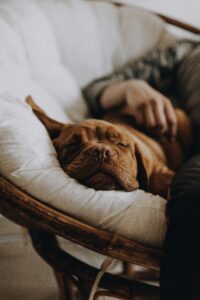Dreams and Whimpers: What Dogs Experience During Sleep
Have you ever watched your dog’s paws twitch, tail wag, or heard soft whimpers while they snooze? It’s one of the most endearing sights for any dog owner — and one of the biggest mysteries. What exactly goes on in a dog’s mind when they sleep? Science tells us that dogs do dream, and understanding their sleep cycles can help you ensure they’re getting healthy, restful sleep.
1. Dogs Dream — Just Like We Do
Research has shown that dogs experience similar sleep patterns to humans, including REM (Rapid Eye Movement) sleep, the stage where most dreaming occurs. During REM, the brain is active while the body remains mostly relaxed — except for the occasional twitch or vocalization.
MIT researchers discovered that rats dream about their daily activities, such as running mazes. Scientists believe dogs likely do the same, replaying familiar experiences like chasing a ball, playing with you, or exploring the yard.
In short: when your dog’s paws move as if running, they’re probably dreaming of something joyful and familiar.
2. The Sleep Cycle: Light Sleep, Deep Sleep, and REM
Dogs move through several stages of sleep:
-
Drowsy Stage: The transition between wakefulness and sleep, where the body relaxes.
-
Deep Sleep: The body repairs itself, builds immune strength, and stores energy.
-
REM Sleep: Brain activity spikes, eyes move under closed lids, and dreams begin.
Puppies and senior dogs tend to spend more time in REM sleep than adults. Puppies, in particular, process new experiences constantly — so they dream more as their brains develop.
 3. Why Dogs Twitch, Bark, and Move in Their Sleep
3. Why Dogs Twitch, Bark, and Move in Their Sleep
Those tiny jerks, quiet barks, or running motions are completely normal. They’re physical responses to what’s happening in your dog’s dream. During REM sleep, motor neurons are mostly “turned off” by the brainstem to prevent full-body movement — but not entirely. A few signals slip through, resulting in those adorable twitches and noises.
However: if your dog’s movements seem violent or they appear distressed, it could be REM Behavior Disorder (RBD), a rare condition where dogs act out their dreams more dramatically. In such cases, talk to your vet to rule out underlying issues.
4. Nightmares: Yes, Dogs Can Have Them Too
Just like happy dreams, dogs can experience nightmares. If your dog suddenly growls, cries, or wakes up startled, they might be dreaming about something stressful. These bad dreams are often linked to past experiences, fear, or anxiety.
What to do:
-
Avoid waking your dog suddenly; it can confuse or frighten them.
-
Use a calm voice if they wake up scared.
-
Provide a safe, comforting environment with familiar scents and routines.
With time and reassurance, most dogs sleep soundly again.
5. Breed and Size Differences in Dreaming
Interestingly, a dog’s size influences dream frequency and duration.
-
Small dogs (like Chihuahuas) may dream more often — sometimes every 10 minutes — but their dreams are shorter.
-
Large dogs (like Labs or Shepherds) tend to dream less frequently, though their dreams last longer.
This is similar to how larger mammals often have slower sleep cycles than smaller ones.
 6. How to Promote Better Dreaming and Rest
6. How to Promote Better Dreaming and Rest
You can help your dog enjoy deeper, healthier sleep — and happier dreams — by improving their environment and routine:
-
Keep a consistent sleep schedule. Dogs thrive on routine.
-
Provide mental stimulation during the day through training, play, and enrichment. A tired mind leads to more fulfilling rest.
-
Ensure comfort. A supportive bed in a quiet, temperature-controlled space promotes uninterrupted sleep.
-
Limit nighttime disruptions. Try to minimize lights, noise, and activity during their rest hours.
7. Why Understanding Dog Dreams Matters
Sleep is more than rest — it’s how dogs process emotions, experiences, and learning. REM sleep helps them consolidate memories and regulate mood. So when your pup drifts off after a long day, they’re not just recharging — they’re mentally growing, too.
Watching your dog sleep can give you insight into their well-being. Happy, relaxed movements often reflect a balanced, content pup. If they’re restless or frequently disturbed, it could indicate discomfort, stress, or health issues worth discussing with your vet.
In Summary
When your dog whimpers or wiggles in their sleep, they’re likely living out the highlights (and sometimes lowlights) of their day. Dreaming is a vital part of their emotional and physical health — helping them process experiences, build memories, and recharge for tomorrow’s adventures.
So next time you catch your furry friend “running” in their sleep, just smile — they’re probably chasing something wonderful in dreamland. 🌙🐾

